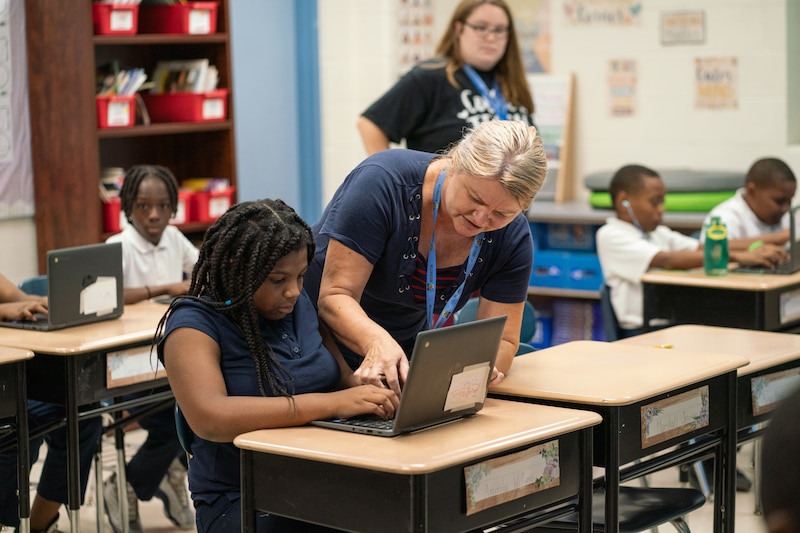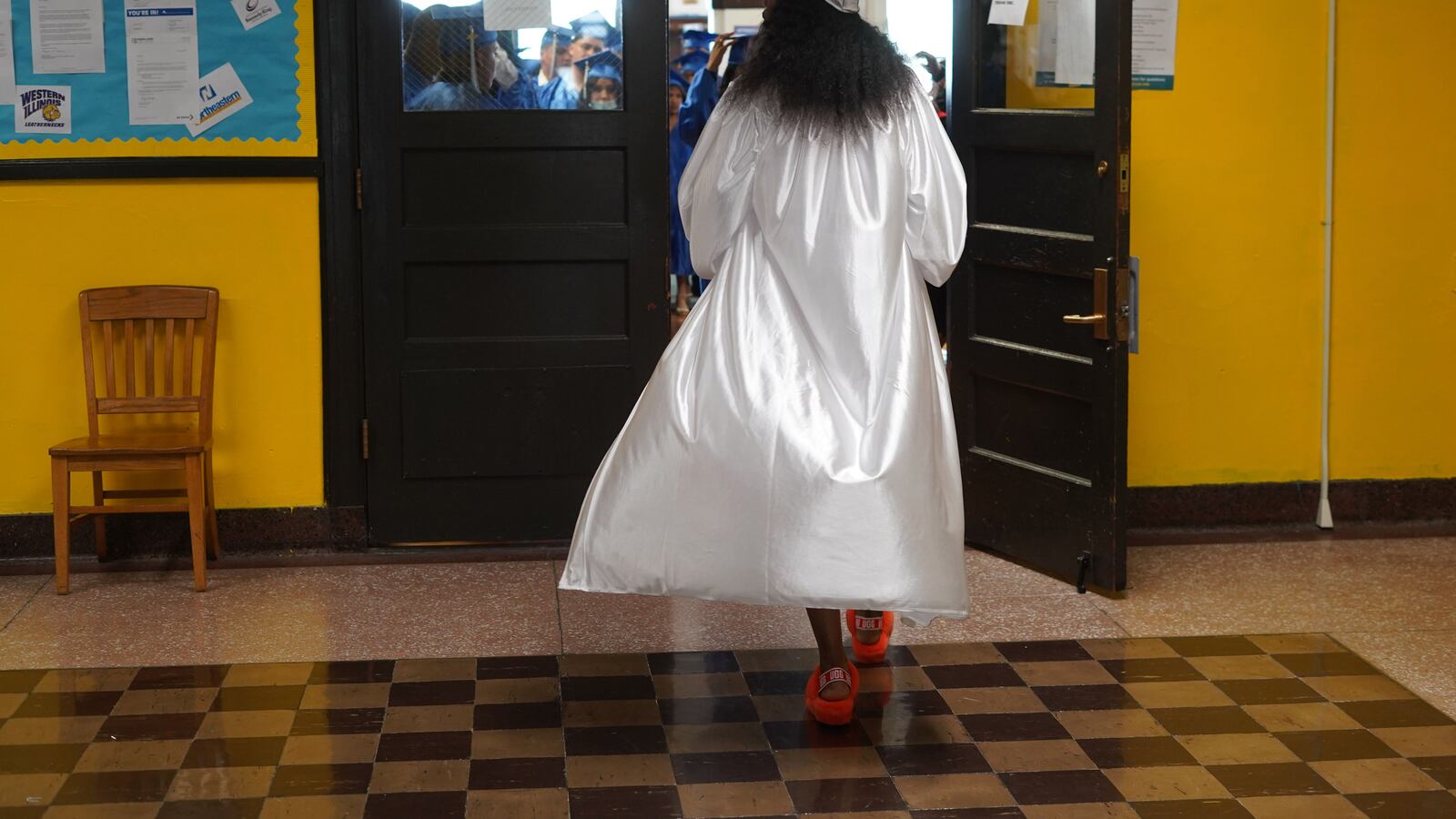Sign up for Chalkbeat’s free weekly newsletter to keep up with how education is changing across the U.S.
This spring, the students who spent most of their freshman year of high school on Zoom will walk across the graduation stage. This fall, schools will face the expiration of billions in pandemic aid that allowed them to reenvision what schools could do for students.
This is a critical year as the nation grapples with the long-term effects of the pandemic amid a technological revolution, a still-unfolding refugee crisis, and a presidential election that could intensify political tensions.
These are some of the education stories we’ll be watching in 2024:
School districts confront the ESSER fiscal cliff
This is the last year school districts will have access to federal pandemic relief, an unprecedented influx of money meant to mitigate the effects of COVID disruptions and support student recovery. Schools received a total of $190 billion in three waves. So far, roughly $122 billion has been spent or committed, and schools still need to spend an additional $68 billion.
Some schools have spent this money on programs directly related to pandemic recovery, such as tutoring and counseling. Some have stood up or expanded programs that help families find housing or provide more intensive mental health support.
Running those programs often meant hiring more people, workers whom districts might not have the money to employ after this year. And while the money is going away, students still have significant needs.
Already major districts, such as Detroit and Montgomery County, Maryland, have announced cuts to services like college transition planning and summer school that were funded with pandemic dollars.
Districts that want to maintain these programs will face tough decisions about where to find the money and what else to give up.
“There was a clear need and with the extra funds, in many cases, really hard-working people responded,” said Marguerite Roza, the director of Georgetown University’s Edunomics Lab. “But you can still say, from the outside, this was really a precarious model. It relied on one-time funds that we knew were going to go away, and we didn’t build anything to last beyond that.”
In some communities, districts have used pandemic aid to shore up budgets amid declining enrollment and to delay painful cuts and school closures. For these communities, 2024 could bring a difficult reckoning.
The expiration of pandemic aid will prompt a larger conversation about what students and schools got from that investment and whether the money was spent well or poorly.

Schools must adapt to serve migrant students
Last year, many school systems across the country — but particularly New York City and Chicago — enrolled thousands of asylum-seeking students from Central and South America.
Some of these children have been out of school for months or even years. Some carry emotional wounds from things they saw and experienced on their journeys. Some are sleeping outside in tents. All are navigating a new country and a new school system with few financial resources.
In 2024, schools will need to rise to the challenge of serving these students over the long haul. Bilingual teachers were already in short supply — and bilingual counselors and school psychologists even more so. Some school districts are stepping up international recruitment to bring in more Spanish-speaking educators.
There are so many new students that cities as different as New York and Denver are seeing enrollment increases after years of declines. Increased enrollment could result in more state funding, but it’s not clear if the additional money will be enough to meet students’ needs or whether these students will stay in the cities where they first arrived or disperse to suburbs and smaller cities.
Many of these students’ needs — for mental health counseling, for academic recovery, for housing assistance — mirror those of students who were already here but at a larger scale or with greater intensity.
Even children who seem OK now may need significant support down the road, said Kevin Dahill-Fuchel, executive director at Counseling in Schools. The nonprofit provides counseling services to about 70 schools in New York City and is trying to expand its bilingual staff. Younger children, especially, may be in a honeymoon period now that they’re physically safe, getting meals at school, and making new friends, he said.
“That’s going to shift as they go from 8 years old to 12 years old. Those pains are kind of festering over time,” Dahill-Fuchel said. One smiling child his organization works with crossed the Rio Grande with about a dozen people who drowned. “That’s PTSD-kind of stuff that’s going to come up later.”
Advocates say schools need to think beyond the immediate crisis. They need to accurately assess where students are academically and think about how to serve older students with limited English skills who may be at higher risk of leaving school entirely. They also see a greater role for state education departments in offering guidance and helping school districts learn from each other.
Will our schools rise to the challenge?
AI will play a larger role in American classrooms — we’re still figuring out the ground rules
ChatGPT is a little more than a year old. In the education space, the new technology’s ability to produce an eerie mimicry of human thought and writing initially prompted fears that students would cheat widely and with impunity.
But a recent Stanford study found that cheating among high school students hasn’t increased much. And while most respondents thought it would be acceptable to use ChatGPT to generate ideas, few thought it would be OK to have AI write an essay for them. “It shows that a majority of students truly want to learn,” the lead researcher told CNN.
In the meantime, ChatGPT and other AI-powered technologies are showing up in the classroom in all kinds of ways. Students recently told Chalkbeat that they’ve used such programs to better understand concepts in history texts or to identify problems in the code they wrote for computer science class. Some schools are using AI to tutor students. The National Education Association has a guide for using ChatGPT to create lesson plans.
Given that the technology isn’t going away, K-12 schools and colleges will need to grapple with what constitutes cheating and what constitutes legitimate use that might even enhance students’ learning experience.
Researchers, meanwhile, are experimenting with using AI to read students’ college essays and grade student papers. Some observers are optimistic about the potential for AI to reduce bias and notice trends, while others worry about inaccuracy and outsourcing human judgment.
The culture wars are dead. Long live the culture wars.
November’s school board elections were generally seen as a setback for cultural conservatives, with Ballotpedia estimating that more than half of candidates endorsed by Moms for Liberty lost their races. The right-wing advocacy group itself is in disarray amid associations with white supremacists and rape allegations against the husband of one founder. The founder acknowledged she had participated in a threesome with her husband and the woman who accused him of assault in an unrelated incident.
But conservative candidates still picked up seats on school boards around the country, where some are reshaping what students learn about U.S. history and how LGBTQ staff and students are treated.
Conservative concerns about progressive ideologies in public schools have also been used to justify the expansion of private-school choice in states, such as Tennessee, Florida, and Arizona.
Even as education politics remains intensely polarized, surveys find that most parents report they’re pretty satisfied with their kids’ schools — and the most negative opinions come from those without children in the schools.
This year could see some of the most intense debates recede into the background or take on new forms. The presidential election has the potential to exacerbate divisions even if education isn’t a dominant issue.
The biggest question is how these debates and policy shifts affect students and families.
Students are reconsidering the value of college — for better or for worse
This spring’s graduating class was in eighth grade in March 2020 when schools shut down, and many of them spent their freshman year — a critical year for students’ academic and social development — mostly online or bouncing in and out school due to quarantines.
These students are applying to college in the aftermath of the U.S. Supreme Court decision banning racial preferences in admissions. They’ve had to rethink how they talk about themselves in college applications. The federal government has delayed the release of a new federal financial aid application, raising fears that fewer students will fill out the form and creating more uncertainty for families waiting on financial aid packages.

Recent surveys show high school students are interested in education after high school but unsure about the value of a four-year college degree. They’re worried about taking on debt and not being able to pay it back. And they want to start earning money sooner.
Conservative parents, too, are less keen on sending their kids to college as they increasingly see higher education institutions as being at odds with their own values.
At the same time, Americans with college degrees still outearn those without.
The most recently available national data on college-going covers the high school class of 2022 and shows overall college enrollment increasing or stabilizing after a sharp dip during the pandemic. But enrollment is down for white, Black, and Native American students.
Meanwhile, colleges are putting more effort into retaining the students they have. High school counselors are rethinking how they support students interested in careers that don’t require a four-year degree.
The decisions the class of 2024 makes could tell us a lot about the lingering impacts of the pandemic and what students need from their schools to be successful.
Senior Reporter Kalyn Belsha and New York Bureau Chief Amy Zimmer contributed.
Erica Meltzer is Chalkbeat’s national editor based in Colorado.


